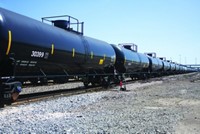Advertisement
Grab your lab coat. Let's get started
Welcome!
Welcome!
Create an account below to get 6 C&EN articles per month, receive newsletters and more - all free.
It seems this is your first time logging in online. Please enter the following information to continue.
As an ACS member you automatically get access to this site. All we need is few more details to create your reading experience.
Not you? Sign in with a different account.
Not you? Sign in with a different account.
ERROR 1
ERROR 1
ERROR 2
ERROR 2
ERROR 2
ERROR 2
ERROR 2
Password and Confirm password must match.
If you have an ACS member number, please enter it here so we can link this account to your membership. (optional)
ERROR 2
ACS values your privacy. By submitting your information, you are gaining access to C&EN and subscribing to our weekly newsletter. We use the information you provide to make your reading experience better, and we will never sell your data to third party members.
Safety
Fertilizer Shippers Seek Liability Deal
by Glenn Hess
August 18, 2008
| A version of this story appeared in
Volume 86, Issue 33
In an effort to ensure that railroads will continue to transport anhydrous ammonia, a source of nitrogen and a key ingredient in the manufacture of phosphate fertilizers for U.S. farmers, the fertilizer industry is trying to strike a deal that would resolve the freight carriers' liability concerns.
Railroads have asserted that their liability is too great to carry anhydrous ammonia and other toxic inhalation hazards (TIH). Fearing that damages in a catastrophic accident could run into the billions of dollars and far exceed their insurance coverage, rail companies asked Congress in 2006 to either put a cap on their liability or grant them the right to refuse to transport TIH materials.
Under federal law, railroads have an obligation to haul extremely hazardous chemicals. But carriers say insurance companies are unwilling to cover the huge financial risks such shipments potentially pose.
After lawmakers decided not to act on the railroads' controversial proposal, the industry shifted its strategy and began urging Congress to include a provision in chemical plant security legislation that would put pressure on manufacturers to phase out the most toxic substances.
To address the railroads' liability concerns and ensure that anhydrous ammonia remains available to farmers, the Fertilizer Institute, an industry trade group, started working with its member companies to devise a business solution rather than a legislative fix, says Pamela D. Guffain, TFI's vice president of member services.
"We came up with a proposal that asks the railroads to carry $500 million in primary insurance," Guffain explains. "Ammonia shippers would form a captive pool, obtain as much excess liability insurance as possible, and make that policy available to the railroads." In return, TFI wants the rail companies to provide rate reductions and stability.
"We've made it clear that this is not an indemnification policy and it is not accepting any liability," Guffain says. "The railroads claim that they cannot get enough liability insurance. So we say, fine; we'll buy some and give it to you. But that is not accepting any responsibility for their accidents."
Over the past year, she says, TFI has met with the seven largest rail companies and the response has been positive. "We felt we made great progress," Guffain remarks. But then on July 22, the Association of American Railroads (AAR) surprised TFI by calling on the Surface Transportation Board (STB), a government regulatory agency, to allow rail carriers to require full indemnification from shippers as a condition for transporting TIH materials. "We were very unhappy and very confused because we thought we were moving forward quite well," Guffain says.
However, AAR Assistant Vice President of Communications Kelly Donley tells C&EN: "We view our STB proposition as complementary to our negotiations with TFI. Our two organizations have worked together in good faith. There are various ways to skin a cat. We don't see our work with TFI as being in conflict with our motion at STB."
Donley says that if the railroads and TFI work out an agreement, then AAR would not need to apply the indemnification requirement it is seeking from STB as a condition for transporting anhydrous ammonia.
TFI views it differently. "We see no reason why the railroads would want to negotiate with us any further if STB gives them full indemnification," Guffain says. "So we are in a holding pattern now. We don't feel that we can go forward with the next step until STB makes a decision."
- » Battle Over Hazmat Liability
- Proposal would shift bulk of risk to manufacturers of toxic chemicals
- » Fertilizer Shippers Seek Liability Deal
- In an effort to ensure that railroads will continue to transport anhydrous ammonia



Join the conversation
Contact the reporter
Submit a Letter to the Editor for publication
Engage with us on Twitter